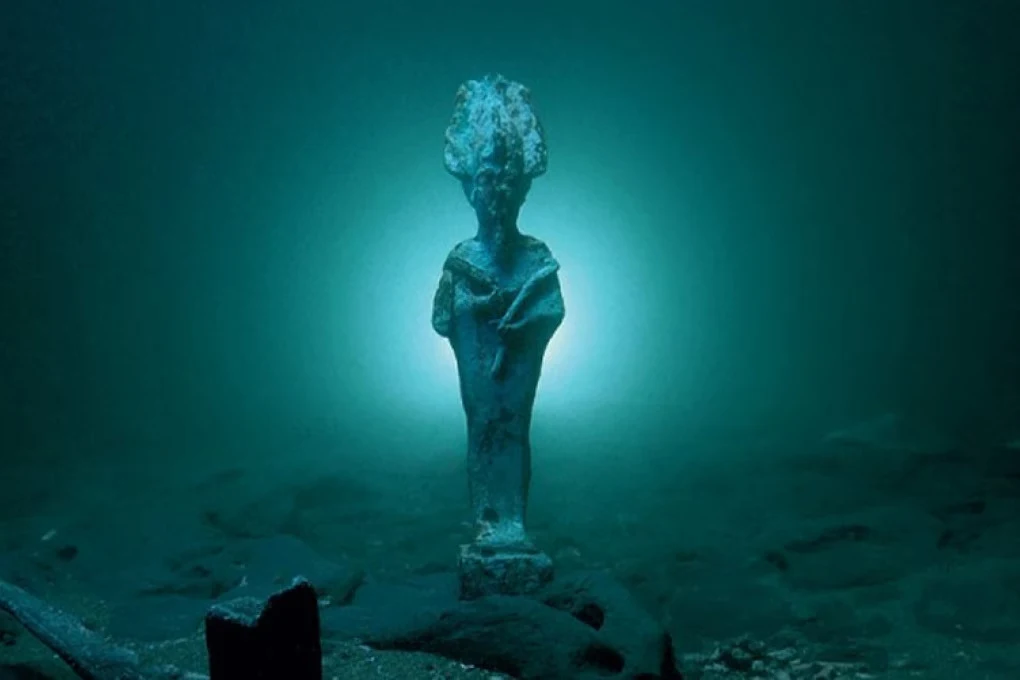The port city of Kanopos Thonis Heraklion
The port city of Kanopos
Thonis-Heraklion
Divers carrying a large underwater dredge vacuumed the top layer of sand to reveal the archaeological layer beneath. Temple ruins Coins and jewelry pottery fragments oil lamps busts black stone tablets were excavated in the temple of the god Nectanebo I Amun-Gereb carved with hieroglyphics from the early 4th century. Sacred offerings The stone tablets also help solve long-standing mysteries with other inscribed monuments. An earthquake in the late 2nd century BC caused the city of Thonis-Heraklion to collapse like a liquid. Starting at the foot of the statue of the god Hapi and the carved stones were ruins. Valuables including antiquities small jewelry and cups fell into the sea. Debris covered the ruins of the city making it impossible to discover by accident. It was abandoned under the sea floor for 1,200 years.
Thonis-Heraklion is submerged directly connected to the Egyptian-Greek trade city submerged for more than 1,000 years. The large red granite gate of one of the ports "Canopus" an ancient port city east of Alexandria is a marsh and islands. The beginning of the 7th century BC and "Araklion" in the past a village called Zoit, an Egyptian settlement that has replaced the old area used by the native Egyptians. It is about the same size as Memphis. The largest settlement in the Thebaid province. Unlike Naukratis, the West Delta has Greek temples and the cult of Dionysus and Zeus. The city's population is also divided into groups and tribes. It has its own government. There are inscriptions and papyrus just like the Greek cities.
The replacement of the city of Tonis by the founding of Alexandria by Alexander the Great in 331 BC established the first capital on the Mediterranean coast. By the end of the 4th century BC Alexandria had become the largest city in the Mediterranean area. The unification of the territory into a city-state and a new territory on the Mediterranean coast. The beginning of the construction of the capital and the planning of the city of Alexandria. Heading east the Egyptian settlement beneath Alexandria preserved the culture and other places. Alexandria, an important industrial center connected to nature. It is the center of Hellenistic civilization in Egypt and the connection point between Greece and the Nile Valley.
Archaeologists have discovered parts of the city. Photo: Christoph Gerigk © Franck Goddio / Hilti Foundation / image : arkeonews
At the end of the 8th century about 101 years ago Tonis sank under the sea. Due to earthquakes and high sea levels Heraklion and its central harbour collapsed. The hard clay quickly turned into liquid and the buildings collapsed into the water. The huge waves at the time when Tonis-Heraklion was submerged in the Mediterranean Sea the city of Tonis-Heraklion began to collapse. The ruins of the city are located in the present-day Aboukir Bay 7 kilometers and 4 miles from the coast about 6 meters underwater.
Divers carrying a large underwater vacuum dredge sucked up the upper layer of sand revealing the archaeological layer below. Temple ruins Coins and jewelry pottery fragments oil lamps busts, Black Stone Inscriptions were excavated in the temple of the god Nectanebo I Amun-Gereb carved in hieroglyphics from the early 4th century. Sacred offerings The inscription also helps solve a long-standing mystery with other inscribed monuments. An earthquake at the end of the 2nd century BC caused the city of Thonis-Heraklion to collapse like a liquid. What began at the foot of the statue of the god Hapi and the stone carvings were reduced to rubble. Precious items including antiques small jewelry and cups fell into the sea. Debris covered the remains of the city making it impossible to accidentally discover it and it was abandoned under the sea floor for 1,200 years.











